The Sistine Chapel
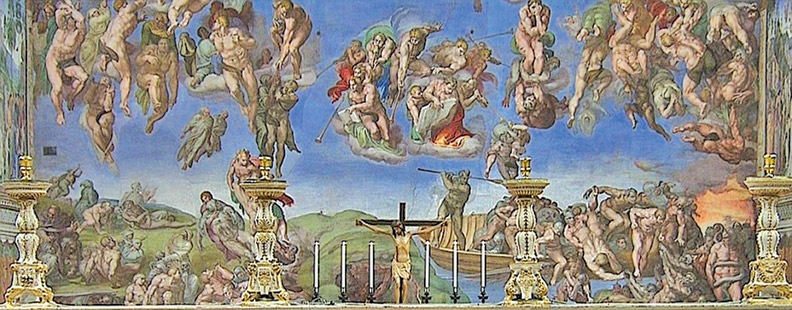
The Sistine Chapel (Latin:Sacellum Sixtinum; Italian: Cappella
Sistina) is a large and renowned chapel in the Apostolic Palace, the
official residence of the Pope in the Vatican City. Originally known as
the Cappella Magna, the chapel takes its name from Pope Sixtus IV, who
restored it between 1477 and1480. Since that time, the chapel has served
as a place of both religious and functionary papal activity. Today it is
the site of the Papal conclave, the process by which a new pope is
selected. The fame of the Sistine Chapel lies mainly in the frescos that
decorate the interior, and most particularly the Sistine Chapel ceiling
and The Last Judgment by Michelangelo.
|
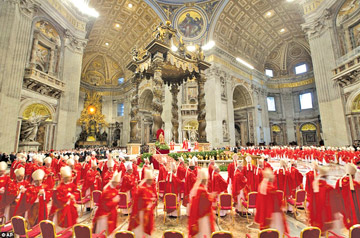
The Papal hall |
|
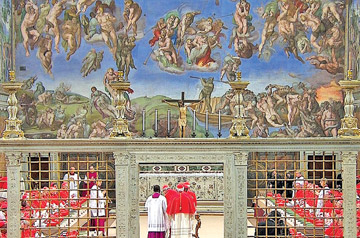
A large and renowned chapel in the Apostolic Palace |
During the reign of Sixtus IV, a team of Renaissance painters that
included SandroBotticelli, Pietro Perugino, Pinturicchio, Domenico
Ghirlandaio and Cosimo Roselli, created a series of frescos depicting
the Life of Moses and the Life of Christ, offset by papal portraits
above and trompel'oeil drapery below. These paintings were completed in
1482, and on August 15, 1483 Sixtus IV celebrated the first mass in the
Sistine Chapel for the Feast of the Assumption, at which ceremony the
chapel was consecrated and dedicated to the Virgin Mary.
Between 1508 and 1512, under the patronage of Pope Julius II,
Michelangelo painted the Sistine Chapel ceiling, a masterpiece without
precedent, that was to change the course of Western art.
In a different climate after the Sack of Rome, he returned and
between 1535 and 1541, painted The Last Judgement for Popes Clement VII
and Paul III.The fame of Michelangelo's paintings has drawn multitudes
of visitors to the chapel, ever since they were revealed five 500 years
ago.
|
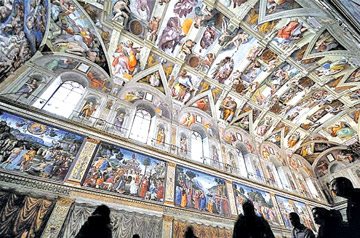 |
|
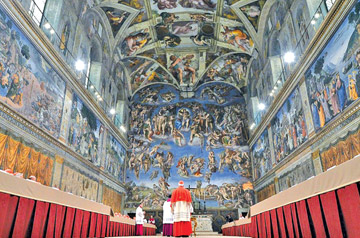
Michelangelo painted the Sistine Chapel ceiling, a
masterpiece without precedent, that was to change the course
of Western art |
The chapel is a high rectangular building, for which absolute
measurements are hard to ascertain, as available measurements are for
the interior: 40.9 metres (134 ft) long by 13.4 metres (44 ft) wide, the
dimensions of the Temple of Solomon, as given in the Old Testament.
Its exterior is unadorned by architectural or decorative details, as
is common in many Italian churches of the Medieval and Renaissance eras.
It has no exterior façade or exterior processional doorways, as the
ingress has always been from internal rooms within the Apostolic Palace
(Papal Palace), and the exterior can be seen only from nearby windows
and light-wells in the palace.
Subsidence and cracking of masonry such as must also have affected
the Cappella Maggiorehas necessitated the building of very large
buttresses tobrace the exterior walls. The accretion of other buildings
has further altered the exterior appearance of the Chapel.
The building is divided into three stories of which the lowest is a
verytall basement level with several utilitarian windows and a doorway
giving ontothe exterior court. Internally, the basement is robustly
vaulted to support the chapel. Above is the main space, the Sistine
Chapel, the vaulted ceiling risingto 20.7 metres (68 ft). The building
had six tall arched windows down eachside and two at either end, several
of which have been blocked.
Above the vault is a third story with wardrooms for guards. At this
level, an open projecting gangway was constructed, which encircled the
building supported on an arcade springing from the walls. The gangway
has been roofed as it was a continual source of water leaking in to the
vault of the Chapel. A reconstruction of the appearance of the chapel in
the1480s, prior to the painting of the ceiling.
Interior of the Sistine Chapel
The ceiling of the chapel is a flattened barrel vault springing from
a course that encircles the walls at the level of the springing of the
window arches. This barrel vault is cut transversely by smaller vaults
over each window, which divide the barrel vault at its lowest level into
a series of large pendentives rising from shallow pilasters between each
window. The barrel vault was originally painted brilliant-blue and
dotted with gold stars, to the design of Piermatteo Lauro de' Manfredida
Amelia.
The pavement is in opus alexandrinum, a decorative style using marble
and coloured stone in a pattern that reflects the earlier proportion in
the division of the interior and also marks the processional way from
the main door, used by the Pope on important occasions such as Palm
Sunday. A screen or transenna in marble by Minoda Fiesole, Andrea Bregno,
and Giovanni Dalmata divides the chapel into two parts.
Originally these made equal space for the members of the Papal Chapel
within the sanctuary near the altar and the pilgrims and townsfolk
without. However, with growth in the number of those attending the Pope,
the screen was moved giving areduced area for the faithful laity. The
transenna is surmounted by arow of ornate candlesticks, once gilt, and
has a wooden door, where once therewas an ornate door of gilded wrought
iron. The sculptors of the transenna also provided the cantoria or
projecting choir gallery.
-Internet
|

